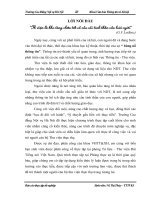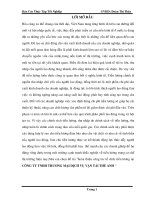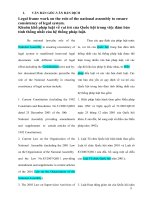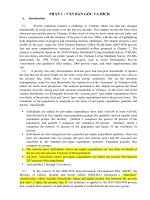Báo cáo thực tập tốt nghiệp tiếng anh (53)
Bạn đang xem bản rút gọn của tài liệu. Xem và tải ngay bản đầy đủ của tài liệu tại đây (405 KB, 40 trang )
PART I: INTRODUCTION
1. Justification of the Study
English is an international language and becoming more and more important
in the economic integration and globalization nowadays. This fact particularly
holds true in the context of Thailand where many aspects of society involved
with the use of English, especially in tourism industry. Due to this, English has
been popularly taught in many colleges and universities in Thailand in order to
equip students with knowledge and necessary communication skills.
Besides domestic programs, many students have sent abroad to learn English.
The countries include America, England, Australia… and Vietnam.
As a student of a cooperative program between Thailand and Vietnam, the
author has spent two years of studying at Vinh University. The author feels that
this is a good opportunity for her and her classmates to study both English
language and Vietnamese culture. However, she herself and her classmates have
also experienced many difficulties both in life and study. They have been
confronted with the differences in the ways of living, the habits, the customs,
etc., which acquire them to change much in order to adapt This naturally
directly affects their study. At university, though having made great efforts, they
still showed dissatisfactions with the results.
Among many of their stated problems, speaking English has been one of the
most obvious one. Many of the author’s classmates have revealed that they did
not develop good speaking skills. The fact that they don not speak Vietnamese
and Vietnamese teachers do not speak Thai should have been good condition
for using English, but this has also been a great obstacle to them in making each
to be understood, especially to those of Thai students who do not speak good
English. This of course caused an invisible barrier between them and much
discouraged the students. On the other hand, as Vietnam is not an Englishspeaking country, generally, Vietnamese students rarely speak English outside
class. Thai students who do not have Vietnamese friends to practice English
1
with eventually speak Thai with their peers. Thus, it is obvious that they do not
have enough practice both in and outside class.
During the process of learning English in Vinh university, the author has
confronted with this problem, and that is the reason the author chooses the topic
“Problems in Learning English Speaking Skills for Thai Students at Vinh
University”, with the hope that this paper might help the learners in the
following courses overcome their difficulties in speaking skill.
2. Aims and Objectives of the study
The study is conducted with the following aims.
1. To find out the problems and difficulties in learning and teaching speaking
skill for Thai students at Vinh University.
2. To find out the main reason for these problems.
3.To suggest some solutions and activities to these problems to partly improve
speaking skill.
3. Methods of the Study
The study is based on the two following methods
a. the collective method
b. the analyzing method
4. Scope of the Study
2
The topic ‘‘Problems in Learning English Speaking Skill for Thai Students at
Vinh University’’ is a general topic and it can not be exploited in the study due
to the limitation of a B.A thesis. Therefore, the study only focuses on the main
problems which cause difficulties for Thai students at Vinh University and the
real situations of teaching and learning English Speaking Skill according to a
survey done it by 15 of Thai students at Vinh University. Besides, from this
survey, some suggestions and solutions are given to improve in learning
English Speaking Skill for Thai Students at Vinh University.
5. Design of the Study
The thesis consists of three main parts:
Part 1: Introduction, the aims, the methods, scope and design of the study.
Part 2: Development consist of 3 chapters:
Chapter 1: Theoretical Background – provides the literature review of the
study,
including definition of key concepts and review of related studies.
Chapter 2: Methodology – describes the participants, instruments, as well as
the procedure of the research. The results of the investigation which present
analyzes and discuss the findings were also presented in this chapter.
Chapter 3: Recommendations – provides the activities to solve the students’
problems discussed in chapter 2.
Part C: Conclusion – summarizes the main issues discussed in the paper,
states the limitations and contributions of the research, recommendations as
well as some suggested directions for further studies.
Summary
In this part of the study, the researcher has briefly elaborated on the rationale
for the study, the aims and objectives together with the scope and methods of
the study. Also, an overview of the other chapters was presented, making it
easier to follow the rest of the paper. Generally speaking, these elaborations
3
have not only sketched out the major contents and structures of the study but
will also work as the guidelines for the whole paper.
PART II: DEVELOPMENT
4
Chapter 1: Theoretical Background
1.1 What is Speaking Skill?
Speaking as an academic discipline relates to all the ways we speak, so it
embraces a large body of study and knowledge. The speaking discipline
includes both verbal and nonverbal messages. A body of scholarship about
speaking is presented and explained in textbooks, electronic publications, and
academic journals. Speaking skill can be defined in different ways. According
to Diane Phillips and Roger Gower. (1995) speaking is the productive skill in
the oral mode. Another definition of speaking skill provided by Brown, H.D.
(1994). speaking is a learned skill. Most people are born with the physical
ability to talk, but we must learn to speak well and communicate effectively.
Speaking, listening, and our ability to understand verbal and nonverbal
meanings are skills we develop in various ways. We learn basic speaking skills
by observing other people and modeling our behaviors based on what we see.
We also are taught some speaking skills directly through education, and by
practicing those skills and having them evaluated.
1.2 Importance of Speaking Skill
Alls skills are important because we have to communicate with people at
work and in normal life. However, speaking has long been our main method for
communicating with one another. It is estimated that 75% of a person’s day is
spent communicating in some way. A majority of your communication time
may be spent speaking and listening, while a minority of that time is spent
reading and writing. These speaking actions reflect skills which foster personal,
academic, and professional success.
The National Speaking Association collected and annotated nearly 100 articles,
commentaries, and publications, which call attention to the importance of the
study of speaking in contemporary society. Themes in the bibliography provide
support for the importance of speaking education to: the development of the
5
whole person; the improvement of the educational enterprise; being a
responsible citizen of the world, both socially and culturally; and, succeeding in
one’s career and in the business.
1.3 Sub-Skills in Speaking
Speaking skill consists a list of speaking sub skills.
1. Producing segmental features of English at word level (especially vowel and
consonant sounds, stressed and unstressed syllables)
2. Using supra segmental features of English (especially intonation, stress in
sentences, word-linking and weak forms) accurately in spoken utterances
3. Expressing grammatical (syntactic and morphological) relationships in
spoken utterances at the level of the sentence
4. Expressing relationships between parts of a spoken utterance through
cohesive devices (especially grammatical cohesion such as noun-pronoun
reference)
5. Using markers in spoken discourse, in particular
6. Sustaining communicative dialog with and without explicit markers
7. Expressing conceptual meaning in spoken utterances
8. Expressing attitudinal meaning in spoken text and utterances (especially by
intonation)
9. Marking the main points or important information in spoken text and
utterances (especially through emphasis or vocal underlining and through
verbal cues)
10. Expressing information or knowledge in informal and semi-formal
utterances
6
11. Planning and organizing information in formal expository discourse
1.4 Problems in Speaking Skill
1.4.1 Pronunciation
Pronunciation problems happen when speaking a second language because
we are used to hearing and making sounds which only exist in their mother
tongue. When they hear or try to say the partially similar or totally different
sounds, it's easy to make mistakes because they are used to hearing and making
sounds in their mother tongue. Besides, in English there are many homophones
and homonyms which make students difficult to distinguish. When having to
talk with teachers, students are often nervous or shy so they can’t pronounce
correctly.
1.4.2 Vocabulary and Grammar
In speaking, vocabulary and grammar are very important. Using vocabulary
and grammar in speaking can be compared to using bricks in building a house.
If students are not provided enough vocabulary and grammar, they can not
express themselves correctly and adequately. Especially when they nervous
they can’t use correct grammar. Misuse of verbs tenses is the most frequent
kind of mistake in this situation
1.4.3 Psychology
To many students, especially beginners, speaking to other people in a foreign
language is a nightmare. They are so nervous and anxious. The reason for this
is that they are afraid of making mistakes and loosing face in front of other
people, especially their peers. Besides, in some cultures, it’s their norms that
girls shouldn’t talk to strangers, so they are naturally very shy, which creates a
barrier to communicate when studying foreign language.
1.4.4 Expressing
7
It happens so many times that we can hear perfectly what other people say,
and know exactly what we are trying to say, but it's almost as if our mouth will
not co-operate with ours brain. We do not know what words to use. That is the
problem of expressing.
1.4.5 Understanding people’ idea
When speaking with some foreigners, we sometimes have problems of
understanding because some of them speak very fast and not clearly. Besides
there are many English dialects with different accents which make us difficult
to follow. Another reason is that people from different countries have different
way of thinking and expressing. For example, English tend to express their
ideas straightly while people in Asian countries tend to “beat about the bush”,
which sometimes causes understanding problem.
1.4.6 Fluency
Many people make long pauses when they speak. This makes the listener
irritated and, as a result, communication becomes less effective. To students
speaking a foreign language, this happens more frequently because they have
many difficulties such as above mentioned.
1.4.7 Translating
Many foreign language learners often translate when listening and before
speaking. This process takes much time and makes them more hesitant.
Moreover, they will face difficulty in expressing their ideas in cases there is no
equivalence between the two languages. Generally speaking, there are two
factors to affect students' speaking English in class. One is they fail to find
suitable words to express themselves and the other is they are afraid of making
mistakes. Sometimes they make mistakes when they are speaking because they
are shy and nervous.
1.5 Summary
8
In short, this chapter deals with some main points relating to the topic about
speaking skill: some definitions of speaking skill according to some web-site,
its importance and some main types of speaking; a popular approach for
language teaching. This part includes twelve sub-speaking skills and seven of
problems in speaking skills.
CHAPTER 2: THE PROBLEMS OF LEARNING
SPEAKING SKILL OF THAI STUDENTS AT VINH
UNIVERSITY: THE SURVEY
1. Aims and Objectives of the Survey
9
The first aim of doing this survey is to investigate the ability of learning
speaking skill of students and find out the main problems or difficulties they
have when learning this skill.
The second aim is to know what can motivate them in speaking lessons.
The third most important reason of doing this survey is to give some
suggestions to motivate students in speaking lessons better based on its results.
2. Participants
The process of data collection involved the participation of Thai students at
Vinh University. To conduct the survey, 15 Thai students of 48 T2 English
were chosen. All students already had, to some extent, background knowledge
about speaking skill. In total, 15 students from Thai students class of English
Language at Vinh university with varying backgrounds were involved in the
data collection process.
3. Method
In order to obtain sufficient reliable and valid data, and to achieve the
research objectives, the survey questionnaire was chosen as the instrument of
data collection.
The reason for this choice was that using questionnaires was particularly
efficient in terms of researcher’s time and effort. By administrating a
questionnaire, a huge amount of information can be collected from a large
number of people within a short period of time.
Furthermore, the questionnaire construction was made convenient for the data
to be processed. The participants only had to select the answer that was closest
to their opinions; therefore, even not very enthusiastic ones could feel
comfortable to answer all the questions. Further information was obtained
through the open-ended questions. These features helped facilitate the data
collation and analysis, as well as the comprehensive collection of information.
The survey questionnaire was designed with 10 questions of which there are 2
multiple choice questions and 8 open questions.
10
4. Procedures
The procedure of data collection consisted of three main phases as follows:
Phase 1
During this period, the survey questionnaires were designed based on the
conceptual framework established in the Theoretical Background. These forms
were then sent to the supervisor of the researcher for feedback. The whole
questionnaire and the wording of several questions had been considerably
improved to avoid possible ambiguity and misunderstandings of respondents.
Also, the pilot survey highlighted the need to establish strict supervision and
consistent understanding of terms to participants to ensure the reliability of data
collected.
Phase 2
The second phase was to conduct the survey. 15 Thai students of English
were selected. The introduction about the study, instructions and definitions of
key terms were given clearly and the researcher was ready to answer any
question that arose in order to guarantee the quality of the information. 15
questionnaires delivered were returned. This turnover rate was quite high
thanks to careful administration of the survey, which had been predicted by the
researcher.
Phase 3
After the data collection process, the information obtained from the survey
questionnaires was classified according to the research questions. Since
previously the researcher had intentionally arranged the questions in
questionnaires corresponding to the research questions, the task became less
complicated.
Consequently, for each research question, participants’ responses were
calculated and transferred into numerical form, for example the percentage
of participants who shared similar ideas or their average rating.
The data were then tabulated and charted for clear presentation and easier
comparison and synthesis. Qualitative data like participants’ answers to the
11
open-ended questions in the questionnaire were summarized and presented
in the form of quotations when necessary to provide more insights into the
issue.
5. Findings
In this part, the data obtained from the questionnaires will be collectively
analyzed and presented in tables and pie charts.
Survey question 1: How important speaking skill is?
a. very important
b. important
c. not important
Figure1: Importance of speaking skill
According to the chart, although those students are from Thai class of
English that most students (93.3%) agreed that speaking skill is very important,
just some students (6.66%) thought speaking skill is important and no one
12
chose it as not important Thus, it is understandable that Thai students of
English are fully aware of their duty to learn and practice speaking skill.
Survey question 2: How much do you like studying speaking?
a. very much
b. much
c. not much
Figure 2: Student’s interest in speaking English.
As can be seen from the chart a lot of students interested in learning English
speaking very much (60%) and much (40%) and no one chose it as not much
Thus, it is show that Thai students are interested in learning English speaking.
Survey question 3: How much time do you spend for speaking each day.
a. 1hour
b. 2 hours
c. 3 hours
13
3 hours
26%
1 hour
2 hours
1 hour
46%
3 hours
2
26%
Figure 3: Student’s amount of time for practicing speaking skill
Unexpectedly, although they like to learning speaking skill, only (26%)
spend 3 hours and (26%) of them spend on 2 hours on practice it. By contrast,
students practice their speaking ability with 46% spending 1 hour. Thus, most
students still use little time on practice speaking each day.
Survey question 4: How often do you practice speaking outside class?
a. always
b. sometimes
c. never
14
Sometimes
40%
Always
60%
Always
Sometimes
Figure 4: student’s practice speaking outside class
Investigation has revealed that a lot of students always practice speaking
outside class (60%) of them, 40% sometimes do and no one chose it as “never”.
Thus, many of them always practice their speaking outside class.
Survey question 5: What mark do you often get for speaking skill?
a. 5-7
b. 7-8
c. 9-10
15
Question
Answers
Number
of
students
5
%
5-7
3
20
7-8
10
66.6
9-10
2
13.33
Figure 5: Student’s marks of speaking skill
As shown in the table above, 13.3% of students get 9-10, 66.6% get 7-8 and
20% get 5-6. Most of them got high marks because they always practice
speaking, some of them those who got low mark need more practice in
speaking.
Survey question 6: How do you evaluate the following?
16
Question
Activities
Answers
Number
of
students
Contents
of Very good
5
33.3
good
8
53.3
Not good
2
13.3
Speaking
Very good
3
20
activities
Good
10
66.6
Not good
2
13.3
Very good
11
73.3
Good
4
26.6
Not good
-
-
Teaching
Very good
6
40
method
Good
9
60
Not good
-
-
the speaking
course
Teachers
6
%
Figure 6: Student’s evaluation of effectiveness of speaking course
This table shows that the teacher are very good (73.3%) of students, and
contents of the speaking course is good (53.3%) ,(33.3%) very good and not
good (13.3%) of them. Speaking activities is good (66.6%), very good (20%)
and not good (13.3%). Teaching method is good (60%), very good (40%) and
no one chose not “good”.
Survey question 7: What are problems you face while learning speaking?
Question
Problems
Answers
Number of
students
17
%
pronunciation
Very
10
66.6
14
100
15
100
9
60
9
60
10
66.6
9
60
11
73.3
8
53.3
serious
Vocabulary
Very
serious
Grammar
Very
serious
7
Understanding
Very
people
serious
Expressing
Very
yourself
serious
Pausing too long
Very
to search for word
serious
translating
Very
serious
Being nervous
Very
serious
Being shy
Very
serious
Figure 7: Student’s problems while learning speaking
The table show that, according to 100% of the students say problem in
pronunciation and vocabulary very serious, 66.6% of them say grammar and
pausing too long to search for word very serious, 60% of them say understand
people ,expressing yourself and translating are very serious problems, 53.3% of
them considered
“being nervous” and 73.3% “”being shy” their serious
problem. Thus, the students have faced all of the mentioned problems while
speaking English.
18
Survey question 8: What activities do you like most in the speaking class?
a. Presentation
b. Talk with partner
c. Talk with topic given by teacher
60%
53.3%
50%
40%
Presentation
30%
20%
26.0%
Talk with partner
Talk about topics
given by teacher
20.0%
10%
0%
a
b
c
Figure 8: Student’s activities like most in the speaking classes
As can see from the chart, speaking with partner was agreed by most of
students (53.3%). It is clear that talk with partner always helps students to have
ability of speaking fluently.
Another method which was mentioned in the survey results by (26%) of them
is talk about topics given by teacher. This is a good way to see the way for
students who have ability of studying because it helps them see professional
speakers vary their tone.
19
One suggested method of chart presentation. This idea was voted by 20% of
the students. This is a very good idea and effective method if students can
manage.
Survey question 9: What topics do you like most in the speaking class?
a. love
b. technology
c. travel around world
d. job in the future
e. custom
Question
Answers
Number
students
9
of
%
a. love
3
20
b. technology
1
6.6
c.
around
travel 2
13.3
the
world
20
d. job in the 6
40
future
e. custom
3
20
Figure 9: Topics students like most in speaking classes
The survey shows that 40% of the students like to talk about job in the future,
20% are interested in such topics as love and custom, 13.3% are interested in
travel around the world and only 6.6% chose technology.
Survey question 10: In your opinion, what should be done to improve the
speaking?
a. talk with friend in English
b. practice more and more
c. talk with native speaker
Figure 10: Student’s opinion what should be done to improve the speaking
As we can see from the chart, speaking with friends in English , practice
speaking more and more and talk with native speaker was agreed the same
21
number 30.3% of students. It is clear that speaking with friends in English,
practice speaking more and more always helps them to have ability of
speaking and importance their speaking. Moreover, speaking with native
speaker also helps them to gain their confidence by getting comfortable
communicating and talk with them.
6. Remarks from the study
The findings from the survey showed that most of the students had
problems with speaking skill. This reveals in their answers of problems they
have faced during the process of studying including pronunciation and
vocabulary (100%), grammar and pausing too long to search for word
(66,6%), understanding other people (60%), expressing themselves and
translating while and during speaking (60%), being nervous (53,3%) and
being shy 73.3%. These problems result not only from the insufficient
linguistic knowledge but also from the lack of practice and the psychological
matter. Even though most of them stated their content to the teacher, the
content, the teaching methodology and activities of the speaking courses, it
can be inferred from the results that more attention should be paid to the
teaching of speaking in order to create more favorable environment and more
opportunities of speaking for students.
7. Summary
In brief, the chapter has presented the methodology used in the study.
Firstly, the main demographic features of the participants involved in the
project were described. The reasons for choosing them as the subjects were
also explained. The next section justified the use of questionnaire as the
main research instrument. Different phases of the data collection and
analysis procedures were depicted in the third part. The procedure of the
data analysis was briefly described. Finally, results and discussion of the
data obtained were presented. In the next chapter, recommendations for the
22
improvement of speaking skill will be proposed, with a hope to orient
interested students in enhancing their speaking.
CHAPTER 3: WAYS TO IMPROVE SPEAKING SKILL
FOR THAI STUDENTS AT VINH UNIVERSITY
The results from the survey revealed that most of the students had problem
with speaking English. Generally speaking, the problems fall into three
categories: the insufficient language knowledge, lack of practice and
psychological matter such as nervousness and shyness. In order to solve those
problems, much effort should be taken from both the teachers and the students.
3.1 FOR STUDENTS
As for the students, in order to improve speaking skill, they should:
3.1.1Continuously improve linguistic knowledge
- Enlarge vocabulary and consolidate grammar by reading more books, journals
in English, from the internet and from other sources;
23
- Improve listening skills in order to understand other people and to be able to
follow the conversation;
3.1.2 Practice more
Students can increase time and create more chances of speaking by:
- Make the best use of the time allotted for speaking skill at class;
- Take part in extra activities such as English speaking club; film showing club;
- Talk in English with Thai friends in and out of class;
- Make friends with Vietnamese and Lao students to have more partners to
practice English with;
- Make best use of talking to Vietnamese and American teachers;
3.1.3 Overcome psychological problems
Students can decrease nervousness and shyness if they:
- Understand that nervousness and shyness are normal and can be overcome
with practice;
- Practice speaking in front of a mirror;
- Recoding their voice and listen again;
- Speak English with close friends first before with others;
- Be open to talk to teachers about their problems so that the teacher
understands more about their situation;
3.2 FOR TEACHERS
24
It is very important for the Vietnamese teacher to understand that Thai
students are different from Vietnamese ones, and therefore they need different
care as well as teaching methods. Being in Vietnam for the first time, Thai
students are like “fish out of water”. They have to cope with many aspects of
daily life, which may very easily distract them from studying. The fact is that
they have very few chances of speaking English outside class because normally
they speak Thai to their classmates and roommates, while they are not
confident enough to speak English to Vietnamese students. In class, due to
limited vocabulary, grammar, they are reluctant to speaking English. Therefore,
it is the teacher who should create a safe and relaxing language speaking
environment, encourage students to open their mouths to speak, adopt various
teaching methods and provide good guidance.
3.2.1 Creating good environment
Generally speaking, there are two factors to affect students' speaking English
in class. One is they fail to find suitable words to express themselves and the
other is they are afraid of making mistakes. Sometimes they make mistakes
when they are speaking because they are shy and nervous. So, good
environment helps the students to speak actively and correctly. The following
are some ways to ease the students and remove their nervousness, fear and
anxiety create a relaxed environment.
- Arrange the seats of classroom in a circle or in groups with the students facing
each other not in rows and lines.
- Let the students speak English sitting in their seats not standing. They will not
feel uneasy this way.
- Let students talk in the sound lab or on telephone without seeing each other.
25









